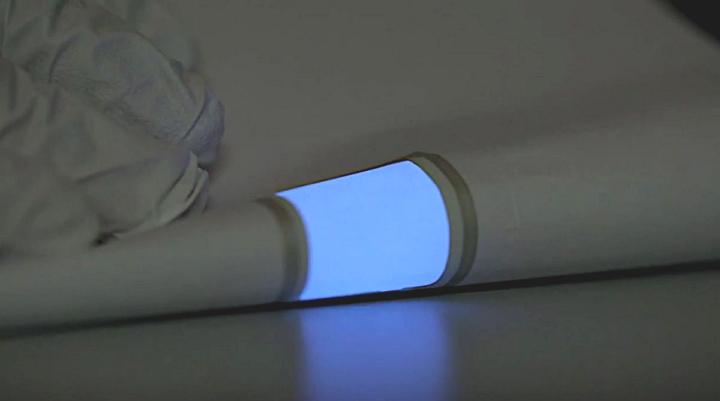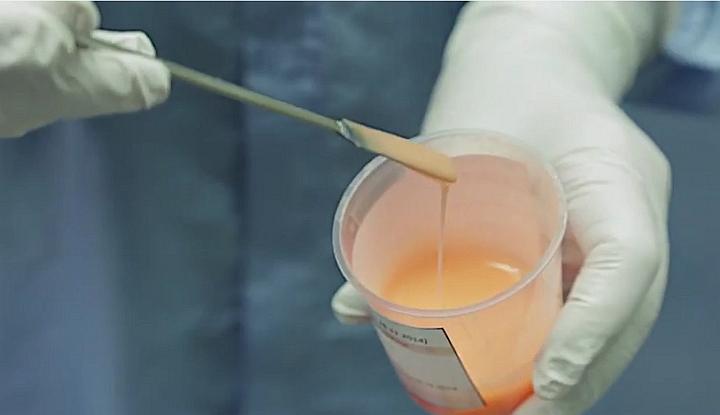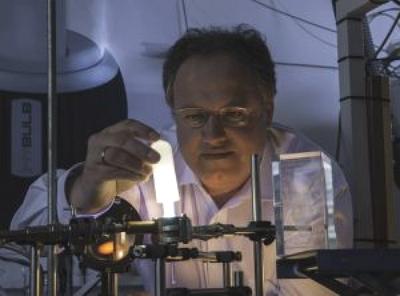 In a development that may one day prove useful to 3D printed objects, the Karlsruhe Institute of Technology says they’ve created a process where conventional, flexible electroluminescent (EL) foils can be applied onto flat surfaces using an imprinting method.
In a development that may one day prove useful to 3D printed objects, the Karlsruhe Institute of Technology says they’ve created a process where conventional, flexible electroluminescent (EL) foils can be applied onto flat surfaces using an imprinting method.
Working in cooperation with Franz Binder GmbH & Co., the process allows for the direct printing of electroluminescent layers onto three-dimensional components to provide a glowing result.
The researchers say these EL components could easily be adapted to safety applications in buildings in case of power failures, and they add that the process might also be used in displays and watches or even interior design.
The process allows materials with flexible surfaces such as paper and plastic to be coated to make them glow.
“By means of the innovative production process we developed together with our industry partner, any type of three-dimensional object can be provided with electroluminescent coatings at low costs,” says Dr. Rainer Kling of the Light Technology Institute at KIT.
Dr. Kling says the this luminescent material is often placed between two plastic layers within what they call “carrier foils.”
Since these electroluminescent layers are printed directly onto a given object without the need for any additional structures, convex and concave surfaces can be coated.
 The electroluminescent and the electrically conductive materials are applied by a pad printing process which uses an elastic rubber printing surface that can easily follow the contours of curved surfaces.
The electroluminescent and the electrically conductive materials are applied by a pad printing process which uses an elastic rubber printing surface that can easily follow the contours of curved surfaces.
One of the engineers who developed the materials and process, Elodie Chardin, says it’s possible to provide many surfaces – and even spheres – with a glowing, homogeneous coating at very low cost.
“Homogeneity of the coating of about one tenth of a millimeter in thickness was one of the challenges of this project,” says Elisabeth Warsitz of Franz Binder. “The process requires a few production steps only and, hence, is characterized by a low consumption of resources. By using various luminescent substances, various colors may be applied to the same surface.”
The research and development work was done by the KIT in cooperation with the Binder Connector Group. The project took approximately two years to complete, and funds came from the German Foundation for the Environment. That foundation funds environmental protection projects.
Can you see applications to 3D printed objects for this technology from the Karlsruhe Institute of Technology? Let us know in the Printing Electroluminescent Coatings on 3D Objects forum thread on 3DPB.com.
Subscribe to Our Email Newsletter
Stay up-to-date on all the latest news from the 3D printing industry and receive information and offers from third party vendors.
Print Services
Upload your 3D Models and get them printed quickly and efficiently.
You May Also Like
Consolidation in AM: How 2025 Is Shaping the Industry’s New Normal
The first half of 2025 has been marked by a clear shift in the additive manufacturing (AM) industry. Companies are no longer just focused on developing new tech by themselves....
Etsy Design Rule Change Reduces Selection of 3D Printed Goods
Online marketplace Etsy has implemented a rule change requiring all 3D printed goods on the site to be original designs. The update to the site’s Creativity Standards states, ¨Items produced using...
U.S. Congress Calls Out 3D Printing in Proposal for Commercial Reserve Manufacturing Network
Last week, the U.S. House of Representatives’ Appropriations Committee moved the FY 2026 defense bill forward to the House floor. Included in the legislation is a $131 million proposal for...
Transforming From Tourist to Native: Duro CEO Michael Corr Explains Why the Company Rebuilt its PLM Software on AI
In these early innings of the AI boom, many market analysts have expressed concern that AI spend has gotten too far ahead of the technology’s proven ability to deliver significant...


































